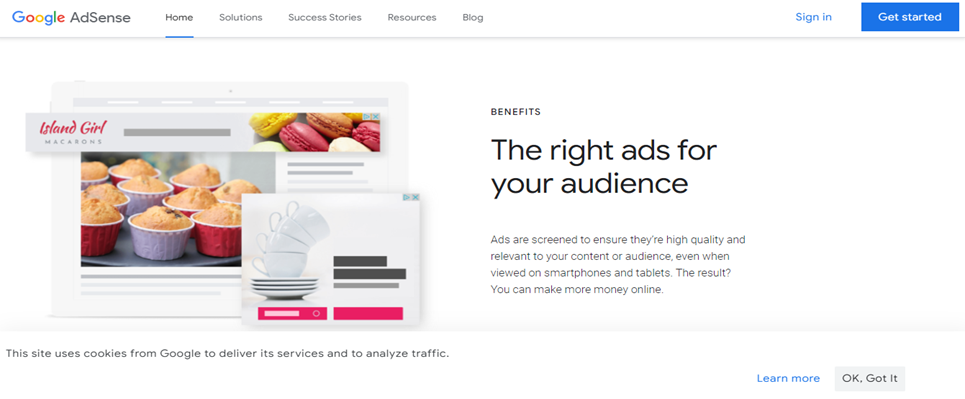
Contextual advertising makes use of a variety of characteristics to identify which material is most pertinent to users when putting an ad.
It’s challenging to think of any type of digital advertising today that isn’t based on browsing habits.
But serving relevant ads to internet users isn’t limited to behavioral advertising. And some claim that it might not even be the most efficient. Contextual advertising is a superior option in some circumstances.
What is Contextual Advertising?
The process of displaying ads on web pages based on the content of those pages is known as contextual advertising.
In other words, it is online advertising that is relevant to the information on the page.

In traditional contextual advertising, automated systems use keyword targeting to display adverts that are relevant to the content of your website.
Google AdSense is one of the more well-known examples of contextual advertising. Google bots provide relevant adverts to your users automatically.

Why Is Contextual Advertising Important?
Contextual advertising is significant because it gives marketers crucial knowledge about the kinds of content that users are interested in.
Then, marketers can target them with an advertisement that entices the user with relevant messaging and content.
Using context instead of depending on prior behavior tells advertisers what users are interested in right now, even as relevant behavioral data expires as consumers explore an environment that is constantly changing.

This can be used to an advertiser’s advantage by providing extremely relevant and timely advertisements.
Companies may also battle with constantly evolving laws, public perceptions of privacy, and strategies that use cookies to give them information about a user’s online activity.
Advertisers are discovering they might not be able to collect data in the same way they formerly did as a result of this shift in mentality.
Contextual advertising's importance in a cookie-free world
Due to the influence of privacy legislation like the GDPR and Google’s announcements to remove third-party cookies, which would prevent advertisers from tracking users across various websites to target them, contextual advertising is experiencing a comeback.
Contextual advertising is increasingly beneficial for advertisers due to the need for more privacy online.

It respects the privacy and allows for the collection of useful customer data without the use of cookies. Additionally, it might keep advertisers in line while enabling more individualized marketing without being provocative.
Behavioral advertising VS Contextual advertising?
There is a role for both contextual and behavioral advertising, so the choice doesn’t have to be either.
Contextual advertising focuses on context, which includes the environment in which the user is browsing as well as the subject and content of the website they are reading. This is the fundamental difference between them.

Inversely, behavioral advertising is more concerned with the choices a user made before arriving at the website, such as clicking on a specific link, visiting a certain product page, or reading an article.
Both forms of advertising can complement one another to get the intended effects and each has advantages of its own.
Advantages Of Contextual Advertising

Contextual advertising can provide a different option that is simple and economical to start with while yet offering some amount of relevance.
Additionally, while though it might not be as tailored as behavioral advertising, its audience will typically be larger, offering a useful option to divert traffic from other websites to your own.
Advertising that is served in context does not rely on private information. For marketers that want to be sure their ads are running on compliant pages, this makes it safer.
Many publishers switched their spending on advertising from behavioral to contextual when GDPR was scheduled to go into force and noticed an increase in ROI.
However, the website that your ad will appear on is the focal point of the campaign when using contextual targeting. The subjects, subtopics, and keywords are specified.
And this lessens the likelihood that your ads will follow a user to a location where they don’t expect adverts and where you don’t want them to appear.
Disadvantages Of Contextual Advertising

Contextual advertising has some drawbacks, including the potential for distraction, the potential for consumer annoyance if they interfere with content, the likelihood that users will ignore them due to their prevalence, and the possibility that their ads will appear next to those of rival companies.
Additionally, customers who are looking for content might not click on anything that is an advertisement.

Businesses can target consumers based on certain patterns by fusing location data and detailed weather data. A cloth producer may decide to target a certain area with advertisements on seasonal days.
A company may use contextual advertising to promote its umbrellas or boost foot traffic on rainy days. When paired with location information, weather-triggered advertising can be a potent tool for influencing consumer decisions.

Google AdSense is among the most well-known cases of contextual advertising. Google bots automatically serve ads that are pertinent to your users.
For example, AdSense may display contextual adverts on your movie review site that push readers to purchase movie tickets or sign up for movie streaming services.
One of the earliest games using in-game contextual advertising before the game loaded was Sony’s Wipeout HD.
As an alternative, YouTube shampoo advertisements that play before videos with instructions on how to cut your hair can be considered an example of in-video contextual advertising.
Contextual advertising includes native advertising. It makes use of sponsored advertisements that mimic website native content in appearance.
These adverts can be personalized using location information and other information.
Conclusion
The decision between contextual advertising and behavioral advertising is difficult to make because both strategies have benefits.
Thankfully, you’re not required to make it. Both fit within the current digital marketing strategy. Utilizing behavioral advertising on website visitors is extremely beneficial.
Relevance along with reach, safety, cost, and ease of implementation make contextual advertising valuable. All of these advantages are useless, though, if your advertisement doesn’t eventually lead to a conversion. And you can’t achieve that conversion without a post-click landing page that works well.
For each contextual advertisement to remain relevant throughout the campaign, it needs its own distinct post-click landing page.
FAQs
Contextual ads: Are they effective?
Yes, According to recent studies, contextual advertising is more exact and economical than behavioral targeting.
A contextual display ad: what is it?
Advertising on a website that is related to the content of the page is known as contextual advertising.
In conventional contextual advertising, automated systems use keyword targeting to display adverts that are relevant to the content of your website.
Contextual marketing: Why is it important?
By offering data-driven information that is tailored to a person’s position and wants, contextual marketing improves the overall customer experience.
Relationships can be cultivated more effectively when engaging material is distributed in the medium that your target audience uses.
What does media context mean?
The phrase “media context” in advertising refers to the setting in which an advertisement appears. Platform placement, additional advertising, and related content are all included.


Hello. And Bye.